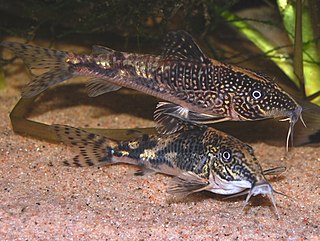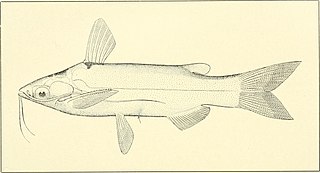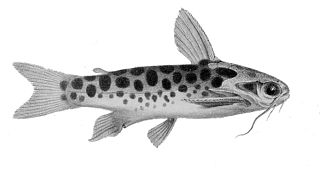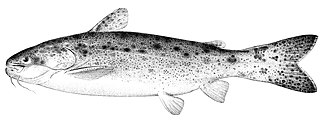
Aspidoras is a genus of catfishes of the family Callichthyidae from Brazil.

Trichomycterus is a genus of fish in the family Trichomycteridae, the largest genus of its family with over 170 species currently described. This genus is native to freshwater habitats in Central and South America. These fish are generally small, usually about 5 to 15 cm (2–6 in) in standard length, although the largest, T. rivulatus, can reach more than twice this size. Species differ from one another primarily in body proportions, fin ray counts and colouration. Despite their relatively small size, some, such as T. punctulatus, support fisheries and are important in the local cuisine.
Otothyropsis is a genus of armored catfishes native to South America.
Hisonotus is a genus of armored catfishes native to South America. Species of Hisonotus and Curculionichthys are the only representatives of the subfamily Otothyrinae having serrae on the posterior edge of the pectoral fin spine. These species are small fishes, generally found in small fast flowing streams, where they grasp to the branches and leaves of aquatic or subaquatic plants. The species of this genus mostly occur in Atlantic coastal streams of southern Brazil and the Paraguay-Paraná system of southern South America. They are also distributed in the Río de La Plata basin and coastal rivers of southeastern Brazil.
Microlepidogaster is a genus of armored catfishes native to South America.
Pareiorhaphis is a genus of catfish in the family Loricariidae native to South America. This genus can be readily distinguished from other neoplecostomines by the unique combination of having fleshy lobes on lateral margins of head ornamented with hypertrophied odontodes on nuptial males, caudal peduncle ovoid in cross section, abdomen usually naked, dorsal fin spinelet ovoid and adipose fin usually present. The color pattern is usually dark brown and mottled with the abdomen white. Most species in to Pareiorhaphis were originally described in Hemipsilichthys. In 1918, Alípio de Miranda-Ribeiro proposed the new genus Pareiorhaphis. Whether Pareiorhaphis is monophyletic or not is currently unknown.

Parotocinclus is a genus of fish in the family Loricariidae native to South America. This genus is distributed through almost all hydrographic systems in South America from the Guyana Shield drainages and Amazon Shield tributaries to the coastal drainages of eastern and southeastern Brazil, including the rio São Francisco basin. Most species have the caudal peduncle oval in cross section. It has been found that Characidium species may interact with P. maculicauda. The small Characidium will follow grazing P. maculicauda, which release particulate matter dislodged from the catfish's foraging.

Scleromystax is a genus of fish in the family Callichthyidae endemic to small tributaries from several coastal river basins draining the southern and southeastern regions in Brazil. Most of the species of Scleromystax are highly sexually dimorphic; males have developed odontodes inserted in fleshy papillae on the preopercular-opercular region and the dorsal and pectoral fins are 2–3 times as long as those of females. S. salmacis is an exception, as its sexually dimorphic features are subtle and non-remarkable.

Entomocorus is a genus of catfishes of the family Auchenipteridae.

Entomocorus benjamini is a species of driftwood catfish found in the Madeira River system in Bolivia and Brazil. This species grows to a length of 7.0 cm and can be distinguished from it congeners in that the distal half of dorsal caudal fin lobe and the edge of the ventral lobe is pigmented.
Entomocorus melaphareus is a species of driftwood catfish endemic to Brazil where it is found in the Amazon River. It grows to a length of 5.9 cm and can be distinguished from its congeners by an inconspicuous patch exists on the dorsal lobe of the caudal fin. It also has pigmented pectoral and pelvic fins, while these fins in the other three species are unpigmented.

Entomocorus radiosus is a species of driftwood catfish endemic to Brazil where it is found in the Rio Paraguay in the Pantanal region of Mato Grosso. It is the smallest known member of its genus growing to a length of 5.3 cm. It can be distinguished from its congeners because its anal fin base is longer and has more branched anal fin rays. E. radiosus is a zooplanktivore which also eats insects; this species predominantly consumes microcrustaceans, but also fed on insects.

Tatia is a genus of small South American catfishes belonging to Auchenipteridae, the driftwood catfish family.
Spinipterus is a genus of catfishes of the family Auchenipteridae.
Otothyropsis polyodon is a species of armored catfish found in the tributaries of the Rio Verde which is a tributary to the upper Rio Paraná basin in Mato Grosso do Sul, Brazil. This species reaches a length of 3.7 cm (1.5 in).
Otothyropsis alicula is a species of catfish in the family Loricariidae. It is native to South America, where it occurs in the Santo Antônio River, a tributary of the Sapucaí River, which is itself a tributary of the Rio Grande and part of Brazil's Paraná River basin. The species reaches 3.6 cm SL and was described in 2014 by Beatriz G. Lippert, Bárbara B. Calegari, and Roberto E. Reis on the basis of morphology and coloration.
Glanidium leopardum is a species of driftwood catfish in the family Auchenipteridae. It is found in the coastal rivers of the Guianas in South America.
Glanidium albescens is a species of driftwood catfish in the family Auchenipteridae. It is found in the Das Velhas River basin in Brazil.

Glanidium ribeiroi is a species of driftwood catfish in the family Auchenipteridae. It is found in the Iguaçu River basin in South America.
Glanidium cesarpintoi is a species of driftwood catfish in the family Auchenipteridae. It is found in the Mogi-guassú River basin of São Paulo, Brazil.







